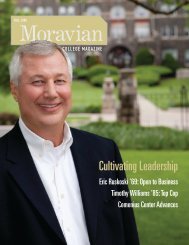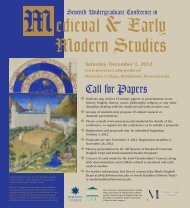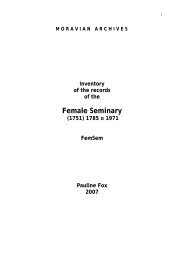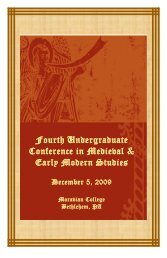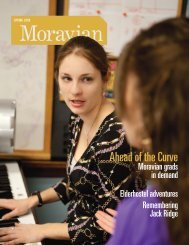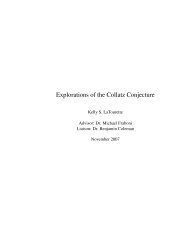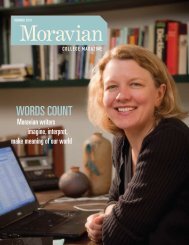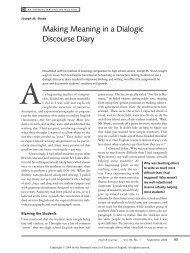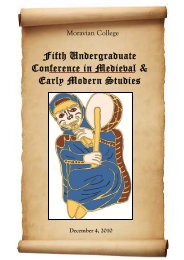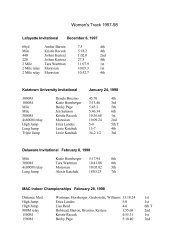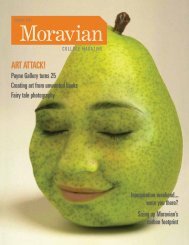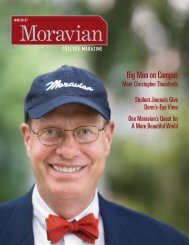Create successful ePaper yourself
Turn your PDF publications into a flip-book with our unique Google optimized e-Paper software.
Who Was the Real LILLIAN HARDIN?<br />
Jazz crept up on Brandi Fogel ’06. First she took up the saxophone; next, she found herself in the high school<br />
jazz band. And, she says, she listened to a few CDs now and again. It was for a time a tepid relationship.<br />
But a passion was budding and it came to fl ower when<br />
she took Neil Wetzel’s jazz class during her fi rst year<br />
at <strong>Moravian</strong>. She fell for jazz and for jazz history. As<br />
a sophomore, she says, she borrowed a half dozen<br />
CDs a week, delving into Stan Getz, John Coltrane,<br />
Charlie Parker, and other stellar performers.<br />
Louis Armstrong also belonged in her pantheon.<br />
She had been indifferent to Dixieland jazz, but<br />
Armstrong won her over to it. In the eight or nine<br />
biographies of jazz greats she had read, two were<br />
about Armstrong. But when it came to choosing<br />
a subject for research in her senior year, her choice<br />
wasn’t Armstrong but the remarkable African-<br />
American woman who had existed in his shadow:<br />
Lillian Hardin.<br />
The more she uncovered about Hardin, the<br />
more she was astonished at the woman’s talents and<br />
character. For a time, Hardin had been Armstrong’s<br />
wife. She was always in his train of admirers and<br />
supporters. But her close ties with him (they both<br />
died in the same week of 1971) had largely eclipsed<br />
her own genius. At various times since she played<br />
the church organ as a young girl, she had been a<br />
jazz pianist, a bandleader, a songwriter, a scholar, a<br />
band manager, and a fashion designer. The songs<br />
she wrote were popular and widely played, though<br />
seldom recorded, largely for lack of adequate<br />
equipment. She was, as Brandi discovered, nothing<br />
short of a phenomenon.<br />
Among her credits, Brandi found, was a gig in<br />
King Oliver’s renowned jazz band, which had a<br />
fanatical following across America. Never known as<br />
an innovative soloist at the piano, Hardin played<br />
the supportive chords to round out the sound. In<br />
that band was an up-and-coming second trumpet<br />
player named Louis Armstrong. They became a<br />
couple, marrying in 1924. Though the marriage<br />
lasted only three years, the friendship continued<br />
and the yoking of the two in the public mind went<br />
on as well. For Hardin it was a bittersweet<br />
connection. She adored Armstrong but, as Brandi<br />
learned, “one of the things she struggled with was<br />
that she was in the shadow of Louis Armstrong.” It<br />
was probably unavoidable. Armstrong was perhaps<br />
the most electrifying, brilliant musician of his time,<br />
whose versatility as an instrumentalist, vocalist, and<br />
stage personality upstaged everyone around him.<br />
Hardin was not one to sulk, however. She studied<br />
classical music, designed clothes that showed in New<br />
York, toured Europe, and had started a book about<br />
her life by the time she died. She also preserved<br />
the music of her time. “Without her,” Brandi says,<br />
“we wouldn’t have much of the music of that age<br />
written down.”<br />
An uncommon woman by Brandi’s lights or<br />
anyone’s lights. Brandi’s search for the real Lillian<br />
Hardin has left her with a profound admiration<br />
for this woman and also a mission. “I am a crusader,”<br />
she says, “to bring Lil out of the shadow of<br />
Louis Armstrong.”



